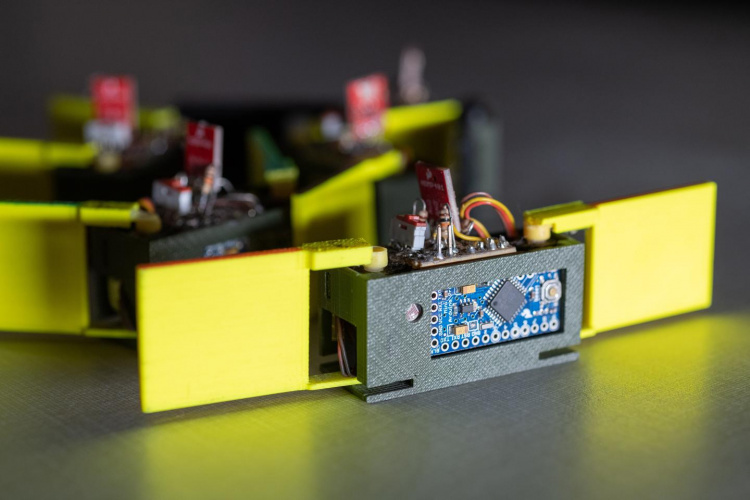An accidental discovery about construction staples led to the development of the swarming robots. Nick Gravish, a doctoral student at Georgia Tech working on a project with the Army Research Laboratory, found that if these heavy duty staples were poured into a box with removable sides, they would self-assemble into tower structures that will stay standing even if the box was disassembled. This, he realised, meant that entangling simple structures could lead to the formation of a composite structure with mechanical properties well beyond those of the original structures.

Developing this idea with Prof Dan Goldman, a Georgia Tech physicist, Gravish designed small robots, around 5 cm across, which could be built on a 3D printer and were capable only of one basic action: flapping their arms up and down. However, when five of these smart active particles – or smarticles – are confined in a circle, they begin to nudge each other and form a robophysical system known as a supersmarticle that can move by itself. As the researchers explain in Science Robotics, adding a light or sound sensor to the smarticles allows the supersmarticle to move in response to the stimulus.

"These are very rudimentary robots whose behaviour is dominated by mechanics and the laws of physics," Goldman said. "We are not looking to put sophisticated control, sensing and computation on them all. As robots become smaller and smaller, we'll have to use mechanics and physics principles to control them because they won't have the level of computation and sensing we would need for conventional control."
_______________________________________________________
Further reading
- Artificial evolution teaches robots to swarm in the wild
- Particle robots work as a swarm to push objects
- Sheffield robot swarm exhibits Turing Learning
_______________________________________________________
The behaviour of the supersmarticle was completely emergent, Goldman said. "Even though no individual robot could move on its own, the cloud composed of multiple robots could move as it pushed itself apart and shrink as it pulled itself together. If you put a ring around the cloud of little robots, they start kicking each other around and the larger ring -- what we call a supersmarticle -- moves around randomly."
The researchers also noticed that if one of the smarticles stopped moving – for example, if it's battery died – the other robots would move towards their stalled companion. This gave the clue to how they could control the movement of the robot swarm. A light sensor added to each smarticles halted its movement when activated, for example by a torch beam.
"If you angle the flashlight just right, you can highlight the robot you want to be inactive, and that causes the ring to lurch toward or away from it, even though no robots are programmed to move toward the light," Goldman said. "That allowed steering of the ensemble in a very rudimentary, stochastic way."
Goldman believes that tweaking the geometry of the individual smarticles would change the way the composite swarm could be reconfigured. This could give rise to more complex interactions, which his army sponsors hope could potentially be used to enhance situational awareness for troops in rugged and difficult to manoeuvre terrain such as forests, caves, or even cities. Sam Stanton, programme manager for complex dynamics and systems at the Army research office, said "For example, as envisioned by the Army Functional Concept for Maneuver, a robotic swarm may someday be capable of moving to a river and then autonomously forming a structure to span the gap.”










PMI falls as manufacturers feel the squeeze
17 months or two and a half years - which is it?